Author: Matt Waldron
It’s no secret my fellow Brülosophy comrades love the beer clarifying powers of gelatin– not only is the first xBmt on the topic the most commonly viewed on the site due in no small part to being featured in basically every article, but gelatin as a variable has been investigated more than any other. However, it’s not what I use. I love clear beer as much as the next person, but my wife and brewing partner, a primary consumer of the beer we make, is vegetarian, so fining with gelatin is out of the question. Given the paucity of post-boil fining options, I was left with few alternatives and ultimately settled on an animal-parts-not-included product called Biofine Clear.
Biofine Clear is described as “a purified colloidal solution of silicic acid (SiO2) in water that has been specifically formulated for the rapid sedimentation of yeast and other haze forming particles in beer.” While the method of action of Biofine Clear is similar to gelatin in that it clarifies by attracting and dropping out oppositely charged particulate matter, they differ in polarity with Biofine Clear possessing a strong negative charge while gelatin has a strong positive charge. Despite being sold as performing the same task, this information indicates each fining precipitates different suspended solids based on the polarity of the particle.
The fact I’ve been regularly using Biofine Clear is evidence of my belief it’s doing something for my beer, though it seems some view this gelatin substitute as having as much utility as a homeopathic small pox vaccine, with stories laden with hazy beer photos “proving” its ineffectiveness. Could it be that I’ve been blindly using a product that doesn’t work as well as a fining derived from slaughterhouse remnants? Even more, does it have an impact on the character of the finished beer? Time to put this one to the test!
| PURPOSE |
To evaluate the differences between a beer fined with gelatin and the same beer fined with Biofine Clear.
| METHODS |
For this xBmt, I wanted to brew a beer that would be light enough to ensure any differences caused by the variable were noticeable and thought a nice Honey Kölsch fit the bill nicely.
Honey Bee Kölsch
Recipe Details
| Batch Size | Boil Time | IBU | SRM | Est. OG | Est. FG | ABV |
|---|---|---|---|---|---|---|
| 5 gal | 60 min | 27.7 IBUs | 4.4 SRM | 1.049 | 1.009 | 5.2 % |
| Actuals | 1.049 | 1.009 | 5.2 % | |||
Fermentables
| Name | Amount | % |
|---|---|---|
| Pale Malt, 2 row (Gambrinus) | 4 lbs | 44.44 |
| Pilsner (2 row) (Gambrinus) | 4 lbs | 44.44 |
| Carapils | 8 oz | 5.56 |
| Honey Malt (Gambrinus) | 8 oz | 5.56 |
Hops
| Name | Amount | Time | Use | Form | Alpha % |
|---|---|---|---|---|---|
| Hallertauer Mittelfrueh | 56 g | 60 min | Boil | Pellet | 4 |
Yeast
| Name | Lab | Attenuation | Temperature |
|---|---|---|---|
| German Ale/Kolsch (WLP029) | White Labs | 75% | 65°F - 69°F |
Download
| Download this recipe's BeerXML file |
My 5 gallon mash in a bag brew day began with the collection and heating of water, during which I milled the grains.
When the water reached strike temp, I mashed in and hit my intended temperature dead-on.
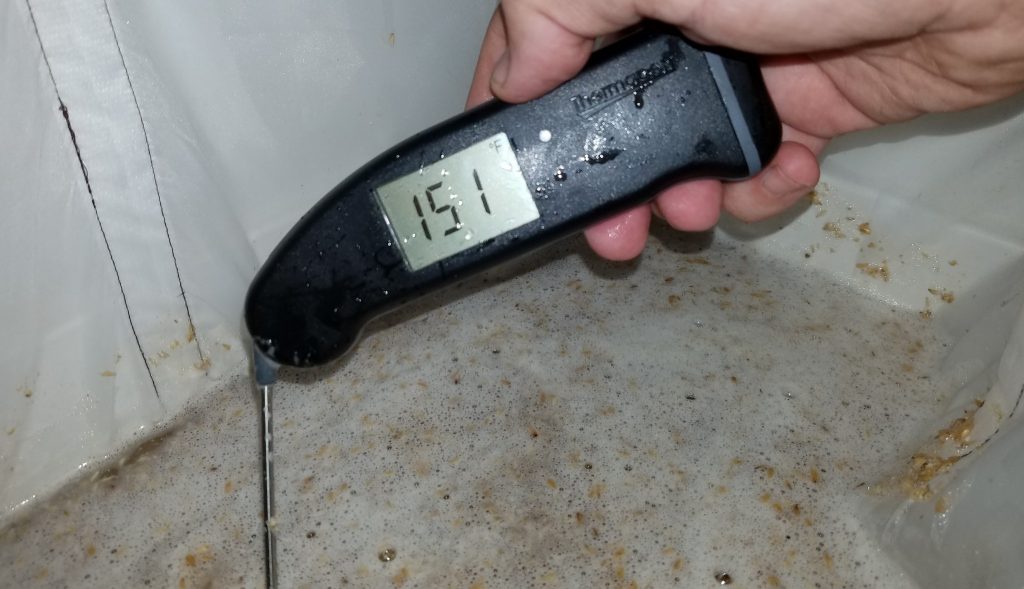
The mash was stirred a couple times over the hour long rest.
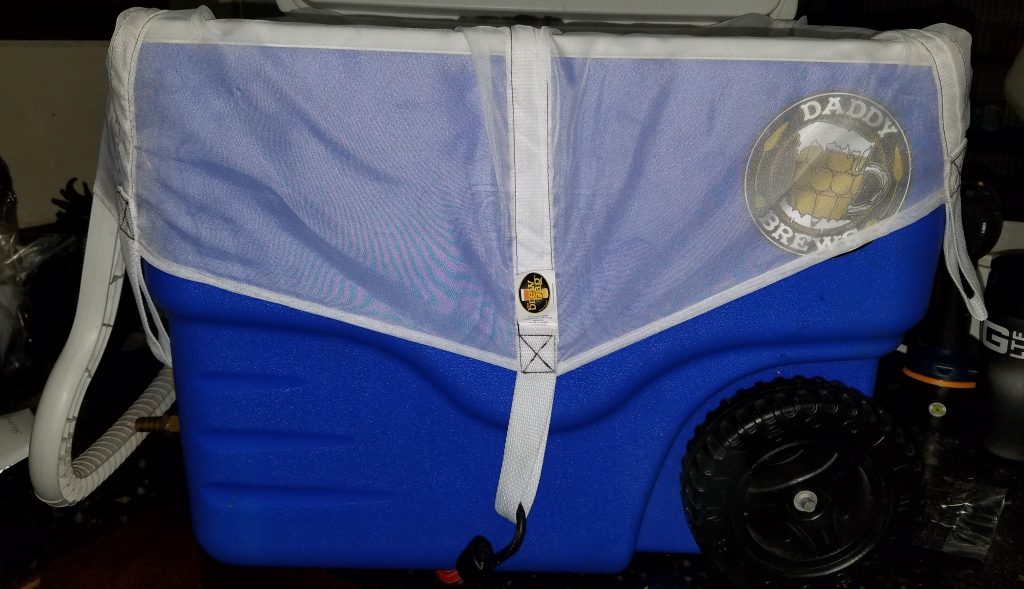
The timer beeped and I collected the wort in my kettle, which would be boiled on my stove-top.
As soon as a boil was reached, I tossed in the single hop addition and let it go for an hour. Once complete, I transferred the hot wort to a clean no-chill cube and left it in a cool area of my house for a few hours before placing it in my 58°F/14°C fermentation chamber. The following day, I transferred the chilled wort to a sanitized fermentor, making a small but appreciated mess.
I pitched 58˚F/14˚C slurry of WLP029 German Ale/Kölsch yeast from a prior batch directly into the wort, forgoing a starter since this was a sub-1.050 OG beer and the slurry harvested not 2 weeks prior. Fermentation was active when I checked on the beer 18 hours later and proceeded without issue. At 1 week post-pitch, I raised the temperature in the chamber to 70˚F/21˚C for attenuation and byproduct clean-up purposes. Signs of activity were absent 10 days later, so I took a couple hydrometer measurements over 2 days that were the same, and the sample was clean with nothing off, so I started the cold crash. After 2 days, I split the beer evenly between two 3 gallon Better Bottle carboys serving as secondary vessels, each receiving approximately 2.5 gallons of beer.
Finally time to introduce the variable! I measured out half the recommended amount of each fining agent given the relative difference in batch size.
A gelatin solution of 1/4 teaspoon combined in 1/4 cup hot water was added to one carboy while approximately 1/4 teaspoon Biofine Clear was added to the other carboy, then both were returned to the cold chamber. In an effort to give both batches a fighting chance, I let the finings work a little longer than some people prefer. After 6 days, I removed the carboys in preparation for packaging and noticed they looked pretty similar at this point.
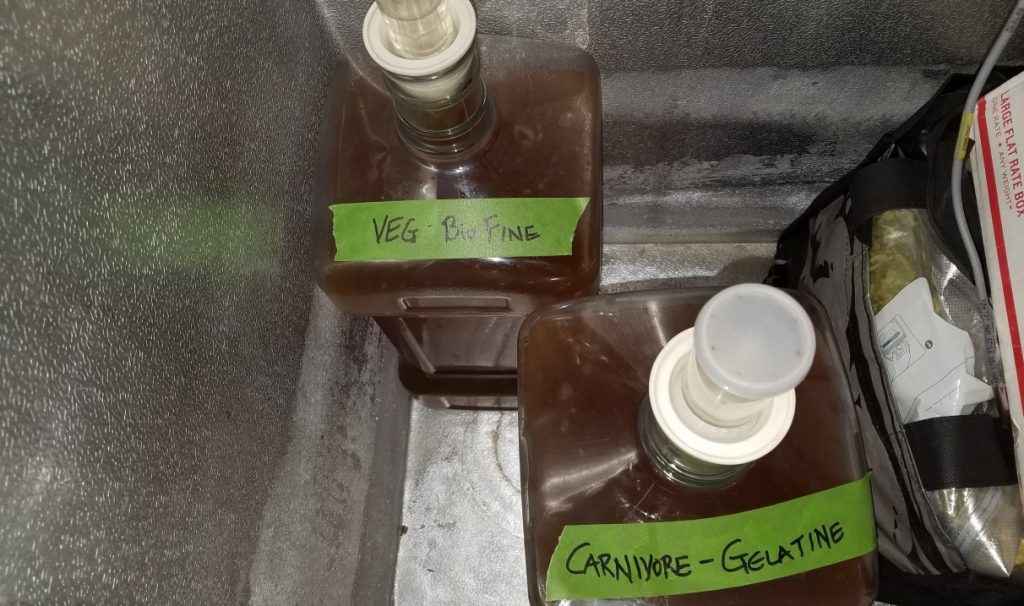
The beer was transferred to 3 gallon kegs then placed in my keezer where they were force carbonated. When it came time to collect data the following weekend, the beers were looking nice and not terribly different.
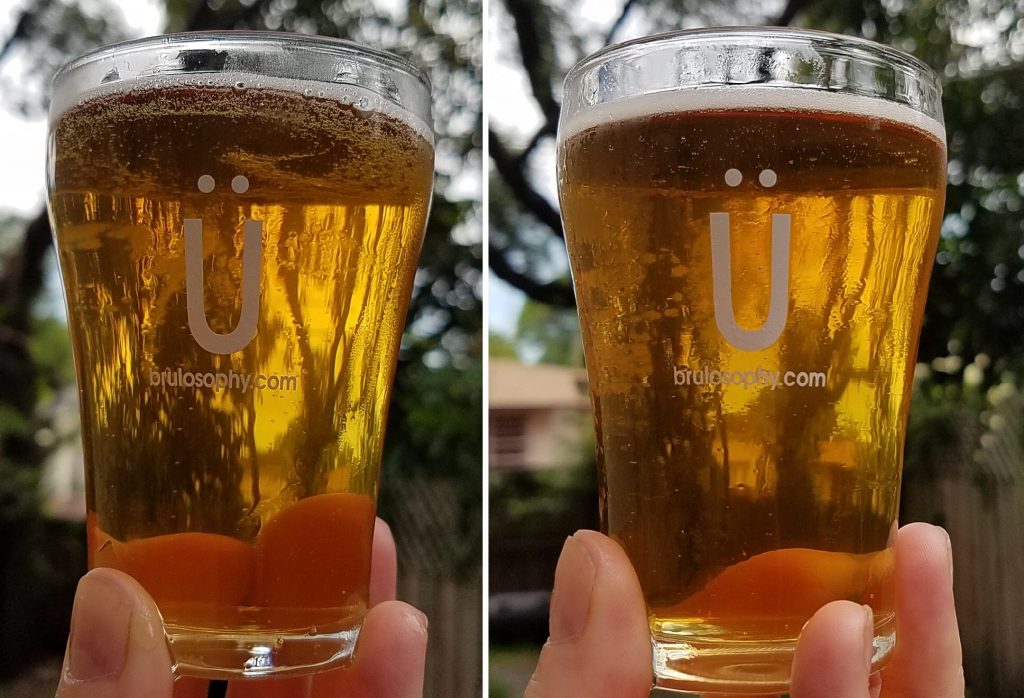
| RESULTS |
A total of 22 people participated in this xBmt, all blind to the variable being investigated. Each taster was served 1 sample of the gelatin fined beer and 2 samples of the beer fined with Biofine Clear in different colored opaque cups then asked to select the one they perceived as being different. Given the sample size, 12 correct responses (p<0.05) would be required to achieve statistical significance. However, only 7 participants (p=0.64) correctly identified the odd-beer-out, suggesting this panel of participants was not able to reliably distinguish a beer fined with gelatin from one fined with Biofine Clear, despite the difference in clarity.
My Impressions: Based on aggravation levels I’d observed online regarding post-fermentation finings, I thought Biofine Clear would have produced a significantly different beer than gelatin, and perhaps this bias would impact my perception of the beers I made for this xBmt. But the finished beers had little difference. At first, earlier on in the process, I thought the gelatin fined beer was slightly clearer and possibly somewhat darker with a vaguely crisper, hop forward aftertaste whereas the Biofine Clear fined beer came across as bready with a malt forward aftertaste. Then I did multiple blind triangle tests and could not pick out the unique sample with any accuracy. In regards to the actual beer, it was really good, the Honey Malt imparting a sweeter twist on the style, yet finishing with a very nice Kölsch-like character.
| DISCUSSION |
As we continue to hammer away at the variable of gelatin and how it impacts beer quality, I find myself consistently surprised with the fact it doesn’t seem to have the impact on flavor many claim. While the Biofine batch did take a little longer to clear than the gelatin fined beer, in the end they finished with a very similar appearance, and there is no evidence to suggest they tasted any different. Prior to my post-fermentation fining days, beers like the one I made for this xBmt tended to require around 2 weeks of cold conditioning after packaging to drop as clear as both the Biofine Clear and gelatin fined beers were in less than a week, which says both products work.
These results are useful to me in that they validated not only my use of Biofine Clear as an effective clarifying agent, but demonstrated it doesn’t seem to have a big impact on the character of the finished beer, at least when compared to gelatin. For these reasons, I’ll continue using Biofine Clear for clarification, confident that my wife and I can enjoy delicious and clear beer sans animal stuffs in less time. For brewers of the carnivorous persuasion, gelatin’s effectiveness combined with its low price-point may make it the more appealing option.
What do you use to clear your beer? Are you a die hard lagerer, do you employ other methods for ensuring your beer ends up clear, or do you even care? Please share your thoughts in the comments section below!
Support Brülosophy In Style!
All designs are available in various colors and sizes on Amazon!
Follow Brülosophy on:
FACEBOOK | TWITTER | INSTAGRAM
If you enjoy this stuff and feel compelled to support Brulosophy.com, please check out the Support Us page for details on how you can very easily do so. Thanks!

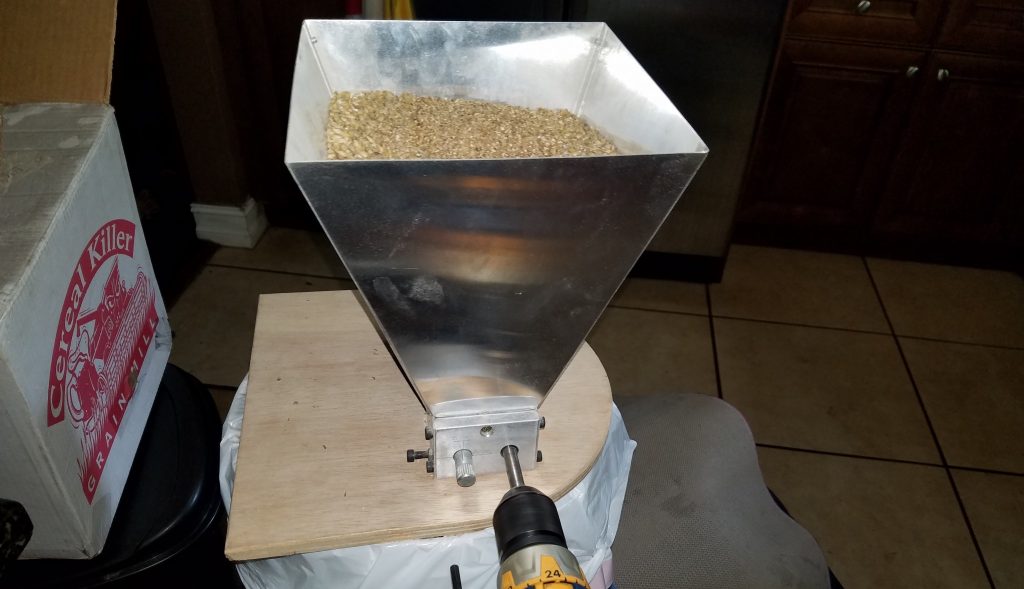
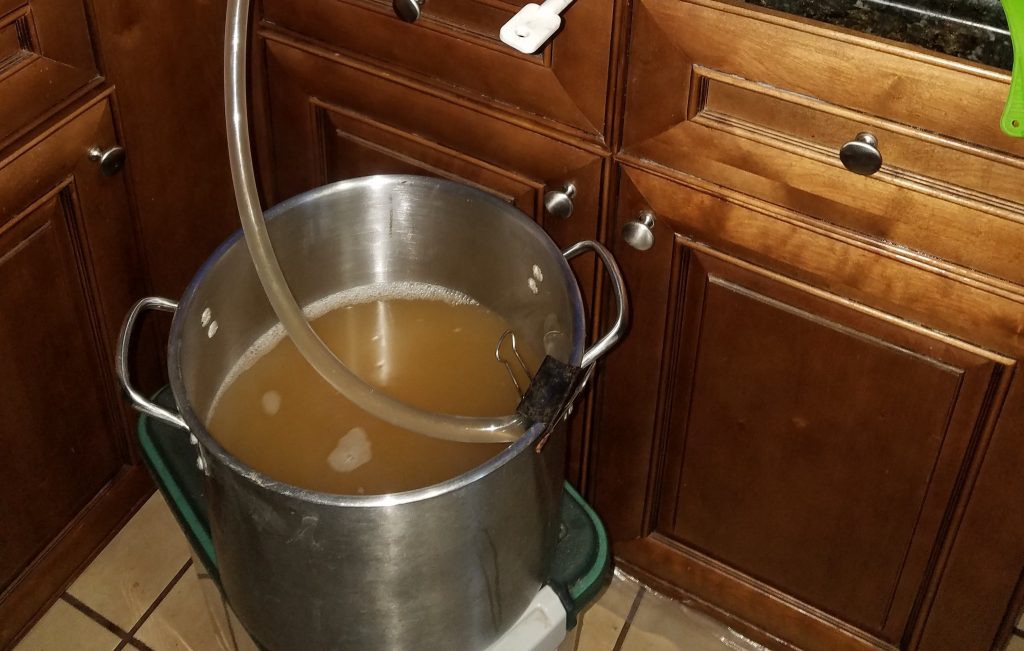
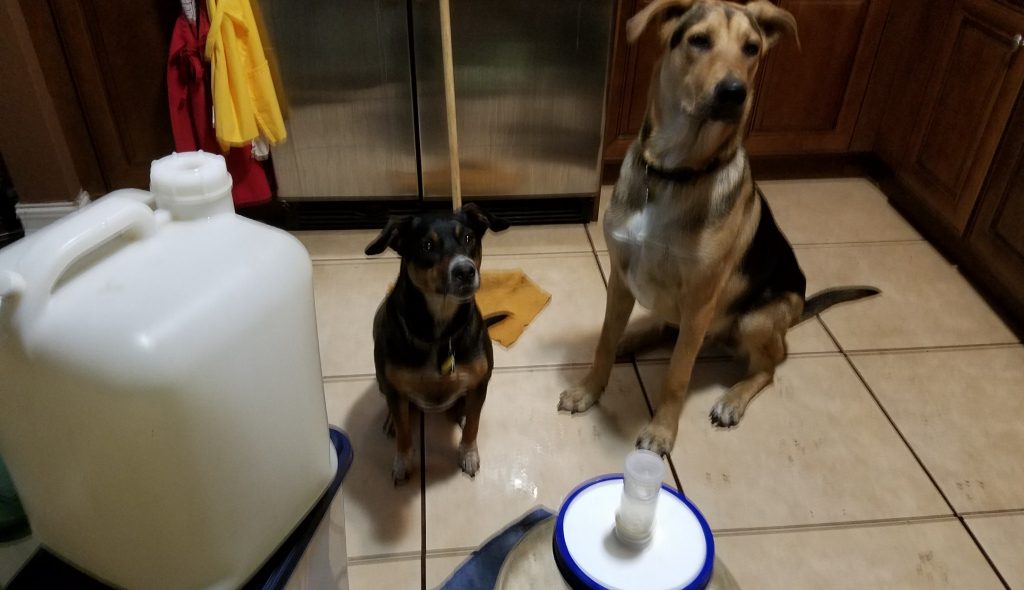
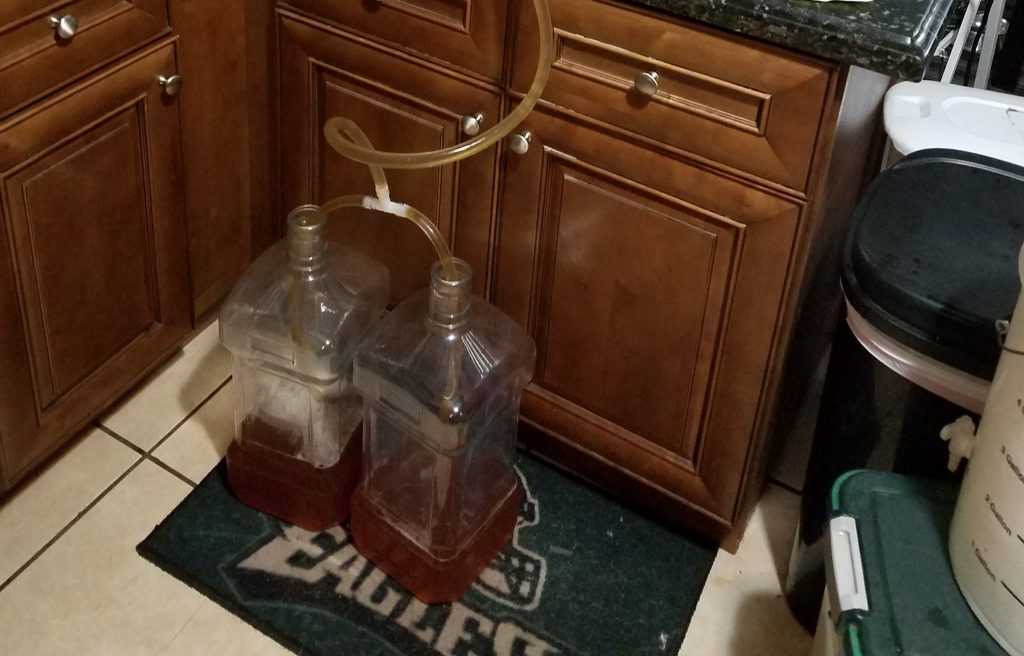
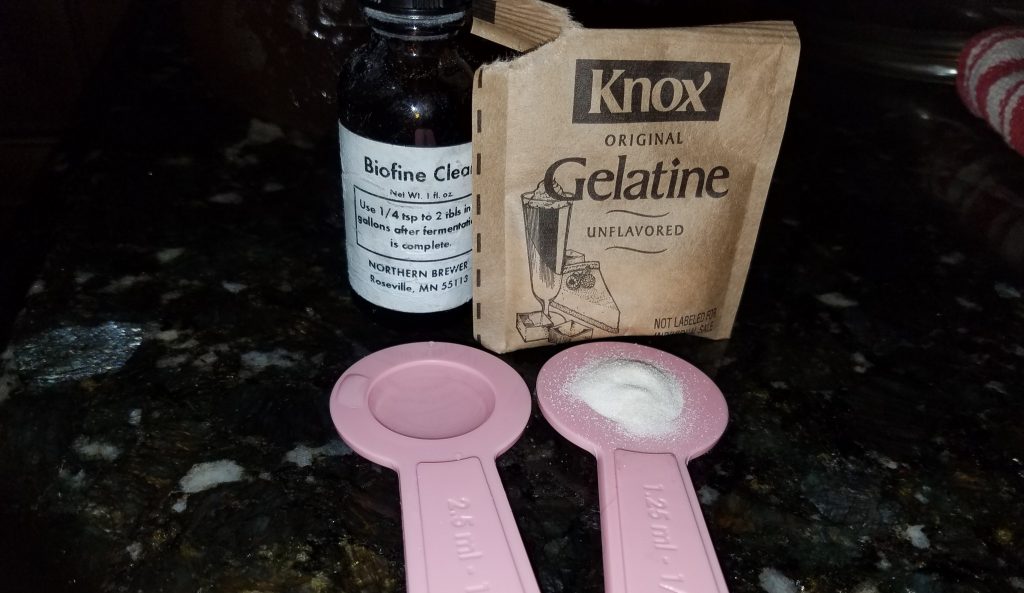










47 thoughts on “exBEERiment | The Gelatin Effect: Gelatin vs. Biofine Clear In A Kölsch”
Did you just dump the gelatin powder directly into the beer? What dosage of Biofine Clear?
Just updated the article to clarify– exactly half the normal amount of the normal gelatin solution into one, 1/4 tsp Biofine Clear into the other.
Ah, so when you write “1/t teaspoon”, it’s for “t = 4”. Got it. 🙂
Heya Marshall, can you fix the “1/t” that appears under the pic of the gelatin pack please? And below in the comments Matt seems to suggest he used 2.5ml of Biofine clear which is half a teaspoon, yet above you say 1/4, so would be good to clear that up (like the beer!).
Diluted the gelatin in warm water before adding it. Though, our previous xBmt seems to indicate it works fine either way.
Also 1/4 tsp Gelatin (diluted) vs. 2.5 ml (1.2 tsb) Biofine Clear.
I live in Europe and was interested in getting Biofine Clear for use in my brewery here. According to a representative of a company which sells Isinglass based finings and algae based finings, “[Biofine] is a form of auxiliary finings made by Kerry. It differs from [algae based finings] in that the polarity has been reversed so it will fine yeast which is negatively charged. The process by which the polarity gets reversed in the finings uses a lot of aluminium salts which leaves a high residue of aluminium in the finings, too high for the EU legislation but apparently alright for the USA.” I don’t use the Isinglass based finings because I think people should have the right to choose what they put into their bodies (even if I am a carnivore). After the story about aluminum salts, I’m not sure I’d be willing to use Biofine Clear…
Did you find info. about the expected concentration of Aluminum in the beer?
That’s absolutely the right question to ask. I didn’t investigate futher since the product is banned in the EU, meaning that I can’t use it either way. I’d be interested in knowing though.
“…..it will fine yeast..” To the point where it would impact bottle/keg conditioning?
I think logically there might be a point where that happens, but I have no proof. That said, it never gets all of it.
Finally, to leave you further without an answer – I have not fined a beer then bottle conditioned it. I started keeging and “bottle wand” ing about the same time I started to think about fining.
For me clarity doesn’t really matter. I think not clarifying beer is what makes home-brew special, different and I understand more nutritious. At any rate, cold crashing seems to do it – my beers pour very clear. I haven’t tried brewing a lager – I might use a clarifier here.
Don’t you guys usually use 1/2 tsp gelatin instead of the 1/4 tsp in this xbmt?
I kind of wish this beer had some chill haze beforehand to see how well both clearing agents work with other stuff besides yeast. Any info on the performance of biofine with chill haze?
Hey there! Thanks for the question. I split a 5 gallon batch for this one, thus the half-sized dose.
Both took some time to get through the chill haze stage, however, gelatin cleared first by a day or show. I wasn’t really watching that variable so I don’t have any exact differences.
Wouldn’t it be more useful to test the two finings with a less flocculant yeast? Wlp029 always gives me crystal clear beer after one week of bottle conditioning – without using any finings.
We generally use gelatin, but It looks like biofine clear is way easier to use… So in a year or so when we run out of gelatin… I think we’ll give it a try. Matt you mentioned an xbrmt where dry gelatin was added? Can you provide direction on that?
Here ya go: https://brulosophy.com/2015/12/28/the-gelatin-effect-pt-3-dry-vs-hydrated-exbeeriment-results/
Questions about how the fining agents were added. Were both carboys swirled/shaken after the addition? Also what was the fining temperature you used in the XBMT and as there any temperature ramping?
Added in secondary, dropped to 38-40 degrees F before adding. Swirled in carboy.
Head Retention.
Is it affected by the use of Gelatin?
cheers
luis
I can’t say if it is all up to the fining, but my gelatin batch has a bit more head, held it a touch longer.
Hi, is it possible to use agar as a fining agent?
Have you tried bentonite on beer and its effects? I use it for mead all the time and it does some amazing stuff. I ask because I believe it should be vegan friendly. It’s clay.
No, but now I really want to.
i used bentonite on a beer i made years ago. i had a bad starch haze and 24 hrs later it was crystal clear
I, like Marshall, now want to run this xBmt. But I also want to do it on a dry hopped beer to see if fining vs. not fining effects flavor. Hmmmm….
This may be why we never run out of things to experiment on…
Excellent experiment. I also use silicon dioxide for fining beers with very good results. I have noticed most people do not know what gelatin really is. Some get quite defensive when you point it out too… Keep up the good work. (My wife is a vegetarian too).
People can get weird about it, but I think like many things in brewing, there is always room for new options, it can just take a while to sink in.
I’ve been looking into the Biofine Clear recently as an alternative as I do know a couple of people who are vegan and it would be nice if they could enjoy my beers too, while I still get the satisfaction of faster clearing beer. My main reason for dropping yeast out is so there’s less sludge in the keg more than clarity, but these things help. I had tried gelatine in the past but it made the yeast sediment too easily disturbed so I switched to isinglass which doesn’t. But yeah now I’m gonna switch again I think. Cheers!
Glad to have helped!
Gelatin is made from the left over parts of animals that have gone to slaughter.
I eat meat and would find it unethical NOT to use it, this way all the animal is used and none of it is wasted which would be disrespectful to an animal that has died so I could eat it.
I used your gelatin fining technique in a Biere de Garde I made a while back, and in addition to being lovely and bright, it also won first place in the farmhouse ale category of a local home brew club contest I entered it in. So add that to your selection of anecdotal success stories 😉
I will admit, there was a learning curve for me getting it “right”…and I might still be learning. Also, LOVE that style, glad it worked.
What type of fermenters are they? I have a 5 cu ft chest freezer that I’m wondering if those would fit in better vs a better bottle.
Those are 2.5 Gallon Better Bottles. They did go away for a while…some kinda design issue, BUT they are back now and I love mine. When you have a five gallon batch and say you want to put oak chips in or fruit…now you can split it and do both. Not to mention a half slim keg is great for storing line cleaner and sanitizer when you brew! Also, if you want to do quick, small-ish batch BIAB, the 2.5 gallon size is quick and easy and will give you a full 24 beers to enjoy!
So while hydrating the gelatin does it matter when you add it to the water and what temperature it is? Does it really matter if you heat up the water too much. I feel like these are questions people get worried about for no reason but I can’t find if it actually matters or not.
Gelatin instructions are to insert into warm water or warm it. The trick Marshall uses is warm water 15 second microwave burst, insert gelatin, stir, 15 second microwave burst, stir. Let cool and add. (Obviously, in a sanitized vessel.) Or at least that is how I remember it. You can check the xBmt backlog and see the hydrated vs. dry gelatin xBmt.
I add the gel to cool water and heat via bursts in microwave. Been doing so for years.
Probably firdt heard of it on HBT and then found reliable directions here –
http://www.bertusbrewery.com/2012/06/how-to-clear-your-beer-with-gelatin.html
Of course now I have our page bookmarked!
https://brulosophy.com/2015/01/05/the-gelatin-effect-exbeeriment-results/
Have you tried using Biofine clear and Clarity Ferm together to make a gluten “free” vegan clear beer?
Bought some gelatin in my local supermarket, made by “Dr Oetker”. I noticed they also do a vegetarian version – this would make a great addition to this “gelatin Vs X” series!
https://www.amazon.com/Dr-Oetker-Vege-Gel-Sachets-6-5g/dp/B01G29BRYU/ref=sr_1_1_a_it
I suspect that the underlying beer itself — and, specifically, whether that beer is heavily dry-hopped and/or late-hopped, and perhaps even the type of yeast used — has a significant impact on the outcome of this exBEERiment. The reason for this is that, based on my own experience with these products and my understanding as to how they work, I believe BioFine Clear is likely to be less effective at removing hop-derived chill haze.
Hop-derived chill haze is created when negatively-charged hop polyphenols bond with positively-charged proteins at cold temperatures. In addition to removing yeast (-), Gelatin also helps settle these polyphenols (-) out of the beer. Without the polyphenols, there is nothing for the remaining proteins to bond to to produce chill haze, so the beer remains clear.
In theory, BioFine Clear, with its negative charge, should similarly remove one-half of the chill haze equation by precipitating chill haze-causing proteins (-). In my personal experience spanning about a half dozen trials on heavily dry-hopped beers (~1 oz. / gal.), however, the beers fined with BioFine Clear retain significantly more haze at cool temperatures. When those beers warm, their clearness matches that of the gelatin-fined beers, indicating that the haze is indeed chill haze and that the BioFine Clear is obviously not removing a sufficient amount of protein to prevent chill haze from forming.
This is a great exBEERiment and very relevant. I’d love to see a similar one performed on a dry hopped beer. Cheers!
(By this same logic, there should also be more yeast remaining in the beers cleared with BioFine clear, since yeast’s negative charge matches that of BioFine Clear. It may be that the cold temperatures and flocculation characteristics of that yeast by themselves were sufficient to clear the yeast even in the sample fined with BioFine Clear.)
Does anyone know if fining before vs after carbonation makes a difference, particularly with biofine clear? Given my setup, it’s easier and faster to use biofine clear after burst carbonating, but I don’t know if that impacts its effectiveness.
If I were guessing, I’d say that it would probably clear better after being carbonated. However, won’t you get a lot of foaming if you add a fining solution to a carbonated beer?
Thanks for the reply. I’ve only done it once, as I just got the biofine clear, but it did not foam for that n=1 sample. Very full keg, too.
I wonder if the article needs a correction on the charge of biofine. This website indicates that Biofine P019 is a refined isinglass collagen that carries a positive charge and since yeast cell walls carry a negative charge, it flocculates them. https://bsgcraftbrewing.com/biofine-p019-1-lb and see also https://beerandbrewing.com/dictionary/228er9hfoV/ Gelatin is also a positive charged flocculant and that’s why both floc yeast. The latter website states that protein flocculation is added by additives that carry a strong negative charge (carrageenans or alginates) – i.e., whirflock. The second website warns about adding a negative and positive flocculate at the same time or they cancel each other out. Guess that’s why whirlfloc goes in the boil and works on chill haze. This raises the question (at least for me) whether it would be worthwhile to add some sort of post-fermentation protein flocculant (with a negative charge) – assuming that whirflock tablet is not 100 percent effective at removing all chill hazing protein. This forum has some good info on the charges of various finings – in the context of wine clearing. https://www.winemakingtalk.com/threads/understanding-fining-agents.16678/ as does this one https://www.winemakersdepot.com/Fining-Agents-Cheat-Sheet-W148.aspx
This exBeeriment is flawed. 1/4 of a tsp is a tiny dose of biofine clear. For crystal clear beer, every time, I use 10 – 15 ml in a 5 gallon batch followed by a second dose of 5 – 10 ml around 12 hours later. Two days later and the beer is crystal clear. Alternatively I combine a dose of gelatine or isinglass followed by a 10ml dose of biofine clear a day later. Same result. No waiting for a week or more for the beer to clear.